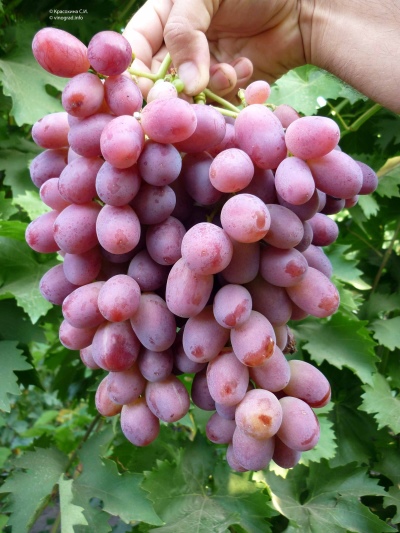
- Authors: Uzbekistan
- Appointment: dining room
- Berry color: pink, with one more intensely colored barrel
- Taste: harmonious
- Ripening period: early middle
- Ripening period, days: 150
- Frost resistance, ° C: -18
- Bunch weight, g: 2000-3000
- Yield: 200-250 c / ha
- Flower type: bisexual
When there is a vegetable garden in a private house, and its owners love to delve into the beds, the question of how soon they will take up grapes becomes relevant very quickly. Lush green thickets not only create additional shade and decorate the courtyard, but also delight with the taste of ripe and poured bunches. One of the most delicious options for planting at home is the Rizamat grape.
Breeding history
This variety appeared thanks to the efforts of scientists-breeders from Uzbekistan more than 50 years ago, who tried to bring out an option unsurpassed in its taste characteristics. The "parents" of this grape were Parkent (round purple berries) and Katta-Kurgan (round green berries). It was named in honor of Rizamat Musamukhamedov, one of the greatest winegrowers of Uzbekistan at that time.
Description
The purpose of the variety is table. Jokingly, Rizamat is called a table-raisin variety, since it has an incredibly rich taste, both in its original form and as a raisin, which turns out to be large and very sweet.
Growing it is a matter that will require a lot of patience and dedication, because the capriciousness of the variety directly correlates with its taste. Those who like to just relax at the dacha should not even bother with the seedlings.
Ripening period
Rizamat grows quite actively - in order to fully mature, it needs to hold out for only 150 days after the growing season begins. The end of summer, namely August-mid-September, is the time when it ripens. Thanks to this, the grapes are classified as early middle varieties.
Bunches
Rizamat will delight those who planted and raised it with large bunches, whose weight can reach 900 g. When using additional means that enhance growth, an average weight of bunches can be achieved in 2000-3000 g. The shape of the brushes in both cases will be conical and branched.
Berries
The pinkish-scarlet berries of Rizamata are very large and filled with the sweetest juice. They are quite fleshy, so raw these grapes are a real dessert. In size, the berries can reach 2-3 centimeters, and in weight they range from 8 to 14 g. The seeds are practically not felt in them, although, alas, they are sometimes found. The shape of the berries, despite the fact that the predecessors of Rizamata were round, cylindrical, however, occasionally there are mixed clusters.
Taste
The organoleptic properties of this grape are highly appreciated by both ordinary consumers and experienced tasters. The acidity of berries can reach 5 g / dm3, while the sugar content is 250 g / dm3. A bright, memorable, harmonious taste will make those who have tried Rizamat at least once to refuse to eat other varieties. Neither a hint of astringency, nor excessive acidity - this grape will appeal even to those who do not like this berry.
Yield
From one bush, you can collect from 20 to 30 kg of berries - a huge harvest pleases gardeners within a year or two after planting. The yield is 200-250 kg / ha.


Growing features
Feeding for Rizamata is a very important condition. Without them, grapes will not be able to produce a good harvest. Before planting it in the soil, you need to fertilize it as much as possible and remove all weeds, otherwise the capriciousness of the variety will only bring disappointment.
Landing
Spring, summer and fall are the best times to plant Rizamata. If the seedling has survived the winter, it should be planted in the ground as soon as the first warm days come. A spacious place should be chosen: this variety grows to gigantic proportions. At the same time, the absence of drafts and an abundance of heat will only benefit the growth of seedlings. The soil should be well prepared and mixed with about 6 kg of fresh manure. It is also worth adding drainage - the layer should be from 5 to 6 cm.

Pollination
This grape variety has bisexual flowers, so sometimes you don't even have to resort to additional means - Rizamat copes with reproduction itself. However, having pollinating plants nearby will always be a plus.
Pruning
Since the bushes of Rizamata can grow up to 10 m around, and reach a height of 5 to 6 m, it must be trimmed periodically. Usually, the lower eyes (from 12 to 15) are removed and this is done in the spring and autumn. When overloaded, Rizamat breaks down very easily.



Frost resistance and the need for shelter
Since this variety is widespread in the south of Russia, it may not be accepted in cold regions: temperatures below 18 ° C are extremely harmful for it. It is necessary to insulate it not only with standard polyethylene. Excessive moisture is also harmful for these grapes: as soon as the watering rate is violated, the trunk will immediately begin to rot, and the berries will burst from excess water.

Diseases and pests
Rizamat has absolutely no immunity to diseases, so the number of chemical treatments on branches should reach from 6 to 7 in one season. The worst diseases for this variety are such diseases as powdery mildew and powdery mildew.

If a grape is exposed to any disease or insect, this always affects its appearance.
Storage
Rizamat is stored quite well, thanks to the sugar content inside the berries and the dense, but thin peel with a weak bloom, it calmly tolerates transportation.In the sun, it only pours with sweetness, so you should not be afraid that the harvest will deteriorate.











































































